Movie Review – Man Who Shot Liberty Valance, The
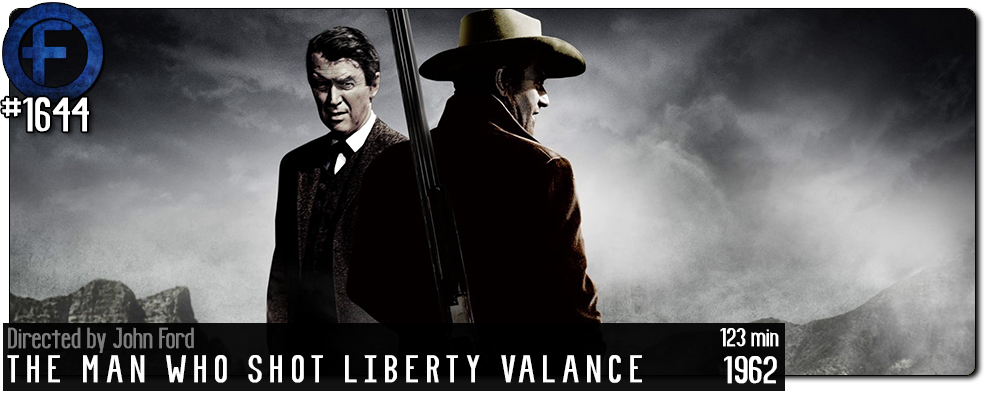
Principal Cast : John Wayne, James Stewart, Vera Miles, Lee Marvin, Edmond O’Brien, Andy Devine, Ken Murray, John Carradine, Jeanette Nolan, John Qualen, Willis Bouchey, Carleton Young, Woody Strode, Denver Pyle, Strother Martin, Lee Van Cleef, Robert F Simon, OZ Whitehead, Paul Birch, Joseph Hoover, Shug Fisher.
Synopsis: A senator, who became famous for killing a notorious outlaw, returns for the funeral of an old friend and tells the truth about his deed.
********
There’s a famous quote, often overused by Hollywood, which says: “The only thing necessary for evil to triumph is for good men to do nothing”. Case in point, the central tenet of this John Wayne/Jimmy Stewart westerner, The Man Who Shot Liberty Valance, a story of a good man who doesn’t want to do nothing but has perhaps an overabundance of moral fortitude not to do the wrong thing. John Ford’s classic 1962 film leans heavily into the dichotomy of America’s classic Old West, the frontiersman in Wayne and the mordernity of Stewart’s intellectual, who find themselves in a moral quandary over the role of local hoodlum and murderer Liberty Valance, played with menacing relish by the legendary Lee Marvin.
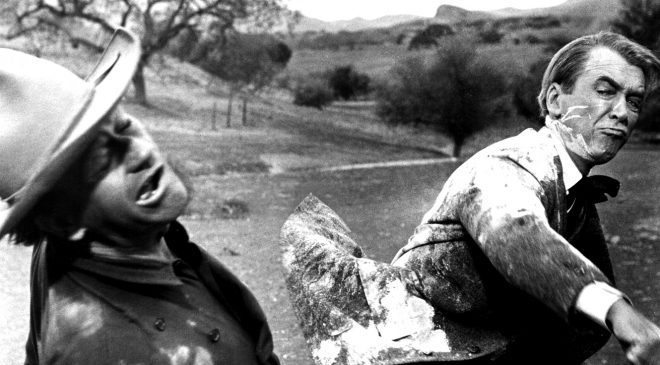
In the American frontier town of Shinbone, elderly US Senator Ranson “Ranse” Stoddard (Stewart) arrives with his wife, Hallie (Vera MIles) for the funeral of an old friend, one Tom Doniphon. With the local newspaper beset with intrigue as to why a man of Stoddard’s status would be there, Ranse tells the journalists about a legendary story of his past, how he came to be known as the man who shot Liberty Valance. 25 years earlier, Stoddard arrived from the East to become a lawyer, but upon arriving in Shinbone and being attacked by Valance (Lee Marvin) and his hoods (including an early role for Lee Van Cleef, who would later star in The Good The Bad & The Ugly, among other classic films), is welcomed in by the townsfolk, particularly local restaurateurs Peter and Nora Ericson (John Qualen and Jeanette Nolan respectively) and their young daughter Hallie, who at that stage is in a romantic relationship with local rancher Tom Doniphon (John Wayne). When Stoddard exhorts the town as to why timid local sheriff, Link Appleyard (Andy Devine) hasn’t arrested Valance, he decides to take up the cause of stopping the man by sending him to prison. Eventually, both Valance and Stoddard are forced into a showdown on the streets of Shinbone, a showdown that will have lasting consequences for both men.
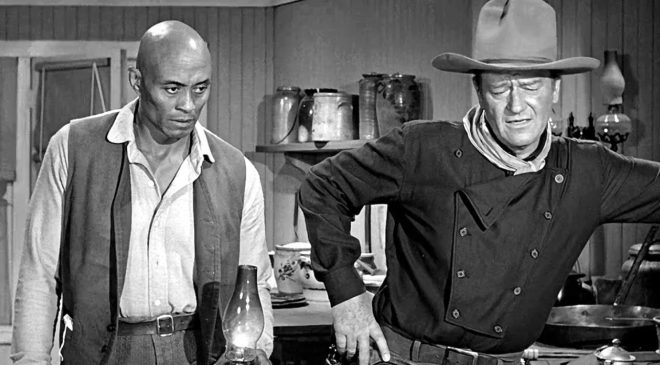
While production on The Man Who Shot Liberty Valance was notoriously prickly between director John Ford, Wayne and Stewart, it is not apparent on the screen. A masterful character study of Stewart’s ageing senator and the ache of regret felt by both he and on-screen wife Hallie, a terrific Vera Miles, the film’s journey into a warren of opposing ideologies isn’t as overt as my opening paragraph might make it seem, but is enjoyable irrespective of your own thoughts. Based on the short story by noted western author Dorothy M Johnson, Ford’s film is scripted by James Bellah and Willis Goldbeck and tackles themes of the period, including the clash between frontier values – everything can be solved at the end of a gun – and the burgeoning American constitutional identity, represented in Jimmy Stewart’s unwavering conviction in the nation’s fledgling beliefs. It’s an interesting perspective, one given a primordial shunt with the casting of the prototypical American Male in John Wayne, a rock-solid masculine behemoth, alongside jackrabbit frame of James Stewart. The difference in their characters’ approaches to solve the Liberty Valance problem drives much of the film’s plot, scattering interesting character work for the supporting roster amid the flurry of showdown preparations.
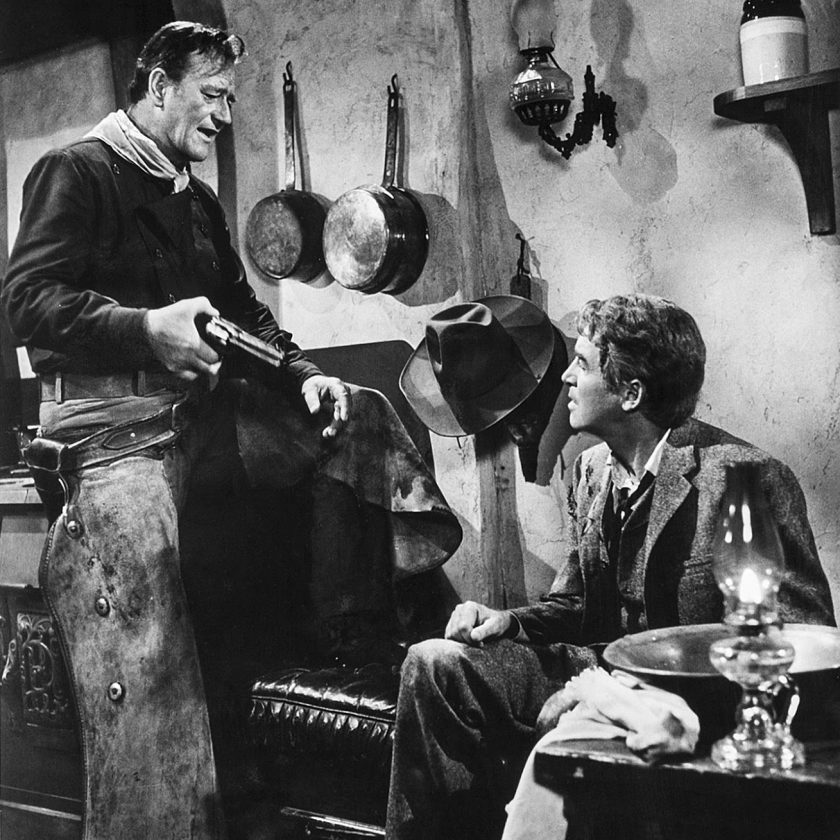
It’s a given that Wayne and Stewart command the lion’s share of screen time. Wayne is laughably patronising almost entirely throughout, referring to Stewart’s Stoddard as “Pilgrim” constantly – it was the actor’s calling card, if you will – and in truth Wayne’s sardonic delivery and staunchly rigid performance style contrasts enormously against Stewart’s far more sage-like patriarchal figure. Stewart, for his part, is excellent, a member of the intelligentsia thrust into the unwelcome scenario of having to pick up a gun to solve his problems. The violence of the Old West could never be talked down, only bred out, and many of the male characters in the film’s central plot – it’s a flashback narrative, this one, in which the beginning and ending of the film see Stewart and Miles in “older” appearance style – are ripped from that cagey, squint-eyed era in American history. Vera Miles’ performance as Stewart’s love-interest vacillates between strong-willed woman of the west and delicate, emotionally torn flower of love, and although never really asked to do much other than wring her hands and look forlornly at Stewart’s gangly frame, brings enough to make the character a fully fleshed out one to bounce off her male leads.
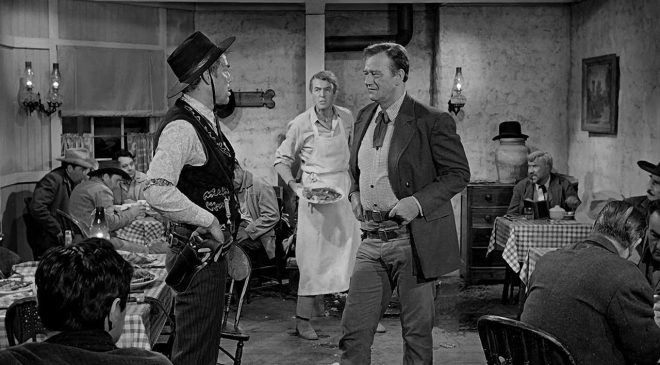
Secondary characters all typify the Western genre roster: the cowardly town sheriff, overplayed by Andy Devine (who, it should be noted, was the voice of Friar Tuck in Disney’s animated Robin Hood, for those playing at home), the wonderful Edmond O’Brien as town newspaperman (and rampant drunkard) Dutton Peabody, and former NFL player Woody Strode as Doniphon’s negro farmhand. Lee Marvin’s aces performance as the titular villain is on point, snarling and brutalising his way through the film to make himself absolutely the guy you want to see get shot, and catching Strother Martin and Lee Van Cleef as Valance’s nasty associates was a pleasant surprise. Perhaps the most problematic aspect of the film’s performances comes with John Carradine’s third-act political aspirant, Cassius Starbuckle (yes, that’s his character’s name, I Googled it), in what has to be the most astonishingly awful overacting I’ve seen in a film in ages. Carradine almost seems to be in a different movie altogether, over-enunciating and theatrically deflating the seriousness of the film’s moment at that point. Still, you have to laugh, don’t you.
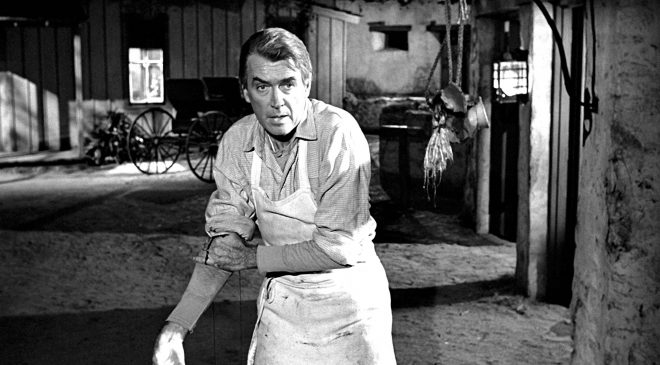
Unlike many John Ford films, The Man Who Shot Liberty Valance was filmed almost entirely on soundstages in the Paramount lot, and it shows. The glorious technicolor vistas of America’s Monument Valley are absent, replaced with crisp monochromatic black-and-white cinematography and a clunky, wooden-set feel that’s not too dissimilar to a studio-bound sitcom. Rumours are that the decision to film in black and white was a creative one, that Ford wanted the intimacy of the characters and story to be more pronounced father than list inside a vividly coloured landscape, but the most likely explanation was simply cost; Paramount reportedly demanded Ford shoot in studio to keep costs down. It was also reported that Paramount demanded Ford cast John Wayne in the role of Tom Doniphon, a decision which did not sit well with the wartime documentary filmmaker, since Wayne did not serve his country during the war like he did. In any case, Ford’s Liberty Valance delivers a masterclass in light and shadow, a film of pronounced editorial exemplification and a truly remarkable tension, although the film’s lengthy epilogue does draw out the “twist” in the tale a touch too much. Yeah, there’s a twist here that you’ll probably see coming a mile away, but is played with grace and delicacy by both actors and production crew. William H Clothier is credited as cinematographer, and I think he did a wonderful job lensing this film.
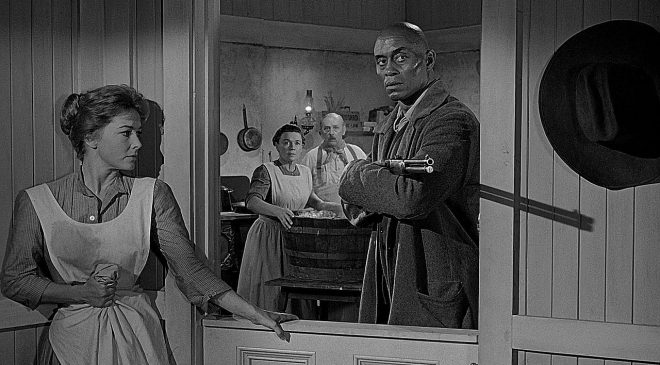
There’s a macabre melancholy shrouding The Man Who Shot Liberty Valance, a sense of loss and the twist of fate making legends out of men who might prefer otherwise. It makes this something of an anti-Western, a film intent on destroying its heroes through the lens of patriotic futurism: Stewart’s Stoddard representing a New America, Wayne’s Doniphon representing the old. A compelling performance by Stewart and a solid hawkinshness by John Wayne, together with Ford’s impeccable sense of timing and location, make The Man Who Shot Liberty Valance an interesting and timely discussion of violence and the rule of law, at a time in American history when that appears to be the antithesis of prevailing sentiment.

